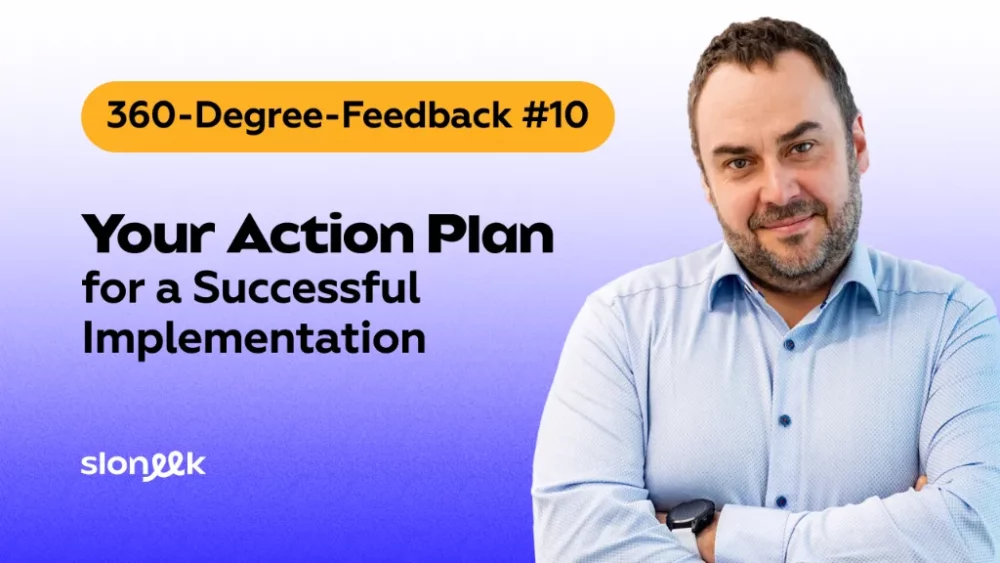360-Degree-Feedback #10: Your Action Plan for a Successful Implementation

We’ve come a long way together, from basic principles to future trends. You might be feeling a bit overwhelmed by the amount of information right now. That’s why, to conclude, I’m offering a practical action plan you can follow to implement 360-degree feedback in your organization.
Phase 1: Strategy and Preparation (Months 1-2)
Weeks 1-2: Defining Goals and Gaining Support
- [ ] Clearly define what you want to achieve with 360-degree feedback.
- [ ] Prepare a business case for leadership.
- [ ] Gain both formal and informal support from key stakeholders.
- [ ] Set a realistic budget and timeline.
Weeks 3-4: Mapping Competencies
- [ ] Identify 5-8 key competencies relevant to the target group.
- [ ] Define behavioral indicators for each competency.
- [ ] Verify their relevance with managers and HR business partners.
- [ ] Prepare a pilot version of the competency model.
Weeks 5-8: Selecting Tools and Partners
- [ ] Map out available technology solutions.
- [ ] Request demos from 3-5 vendors.
- [ ] Decide on internal vs. external facilitators.
- [ ] Prepare a communication strategy.
Phase 2: Pilot Implementation (Months 3-4)
Weeks 9-10: Pilot Preparation
- [ ] Select 10-15 people for the pilot project.
- [ ] Create the final version of the questionnaire.
- [ ] Set up the technology platform.
- [ ] Prepare training materials.
Weeks 11-12: Communication and Training
- [ ] Introduce the project to the pilot participants.
- [ ] Train raters on how to provide feedback.
- [ ] Address any questions and clear up any confusion.
- [ ] Launch the data collection.
Weeks 13-16: Data Collection and Feedback
- [ ] Monitor the progress of questionnaire completion.
- [ ] Provide technical support as needed.
- [ ] Generate individual reports.
- [ ] Conduct feedback conversations.
Phase 3: Evaluation and Optimization (Month 5)
Weeks 17-20: Evaluating the Pilot
- [ ] Gather feedback from all participants.
- [ ] Analyze the quality of the data and the usefulness of the outputs.
- [ ] Identify areas for improvement.
- [ ] Adjust the process based on the findings.
Phase 4: Full Rollout (Months 6-8)
Preparation and Communication
- [ ] Finalize the process based on learnings from the pilot.
- [ ] Prepare a company-wide communication campaign.
- [ ] Train all facilitators and administrators.
- [ ] Set up the system for a larger number of participants.
Implementation
- [ ] Launch the process for the entire target group.
- [ ] Provide support throughout the entire cycle.
- [ ] Track key metrics (participation, data quality).
- [ ] Address issues as they arise.
Phase 5: Development and Follow-Up (Months 9-12)
Development Activities
- [ ] Help participants create Individual Development Plans (IDPs).
- [ ] Organize follow-up training and workshops.
- [ ] Arrange for coaching and mentoring.
- [ ] Track progress on development activities.
Measuring Effectiveness
- [ ] Define success metrics.
- [ ] Monitor changes in behavior and performance.
- [ ] Collect success stories.
- [ ] Prepare reports for leadership.
Key Principles for Success
- Communicate, Communicate, Communicate: You can never communicate enough. People need to know the why, how, when, and what will happen with the results.
- Start Small: It’s better to do a pilot project well than a large project poorly.
- Invest in Training: The quality of feedback depends more on the readiness of the raters than on anything else.
- Maintain a Developmental Focus: If you start using the results for administrative decisions, you will lose trust and honesty.
- Be Patient: Behavioral change takes months, not weeks. Don’t expect immediate results.
- Learn and Improve: Every cycle is an opportunity to learn. Collect feedback and continuously improve the process.
Your Journey Starts Now
360-degree feedback isn’t just an HR tool—it’s an investment in your organization’s future. When you implement it correctly, you can expect:
- Better self-awareness among your key people.
- Concrete data for targeted development.
- The gradual building of a feedback culture.
- The identification of hidden talents and problems.
- Measurable improvement in leadership competencies.
The journey won’t always be easy. You’ll face resistance, technical issues, and maybe even setbacks. But if you stick to the principles described in this guide and remain patient and persistent, the results are worth it.
Remember: successful 360-degree feedback isn’t about perfect technology or complicated processes. It’s about helping people grow and making the organization a better place to work and live.
Now is the time to start with help of our 360-Degree-Feedback Action Plan. Which phase will you tackle first?




